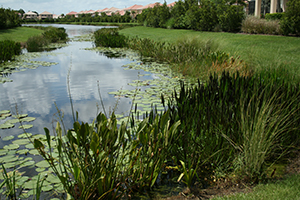Protecting Florida’s Water Resources

The Earth is covered with water, and our stunning state has more than its fair share of shoreline to boast. Florida has the second greatest mileage of shoreline (8,436 miles) according to the National Oceanic and Atmospheric Administration (NOAA) Office for Coastal Management. Only Alaska has more shoreline in the United States.
Additionally, Florida is home to 7,700 lakes that are larger than 10 acres and according to UF Lakewatch, probably has more than 100,000 smaller bodies of water. The state also has over 10,000 miles of rivers and streams and more than 700 freshwater springs.
Beneath the surface lies the Floridan aquifer which is one of the most productive aquifers in the world. The Floridan aquifer not only lies beneath the entire state of Florida, it also lies below parts of Alabama, Georgia, and South Carolina.
But even with all these resources, the supply has its limits. With more than 1,200 people moving to Florida every day ¹, it’s easy to see why we must all do our part to protect this vital resource.
Florida-Friendly Landscaping™ and Protecting our Water
Many Florida-Friendly Landscaping™ principles can offer guidance so you can protect the water in and around Florida.
Principle #2 – Water Efficiently
Conserving water is an important part of protecting our resources. Group plants with similar water needs together and set up your irrigation zones properly. Landscape irrigation systems are designed to supplement natural rainfall when necessary. Don’t water or irrigate if it is going to rain and look for signs of wilt in your grass or plants to know when to irrigate. Irrigate in the morning to prevent loss of water due to evaporation and check for any local watering restrictions, such as day of the week or time of day. Handwater when possible, using a watering can, pail, or hose. Check your irrigation system regularly; repair any leaks, clogs, or breaks and make sure all sprinklers are irrigating your plants, not the sidewalk. Calibrate your irrigation system for maximum efficiency. Mulch and mow properly to increase plant health and drought tolerance and use microirrigation wherever possible. A rain barrel is a great way to save water and money while keeping rain water on site for you to use.

Principle #3 – Fertilize Appropriately
Keeping pollutants out of the water is key, that is why it is important to fertilize appropriately. Get a soil test and fertilize only when necessary. When you do fertilize, do so according to UF/IFAS recommended rates and application timings to prevent leaching — fertilizer leaking down through the soil rather than being absorbed by plant roots. Look for fertilizers with low-release nitrogen and little or no phosphorous. If you spill fertilizer on the lawn or on a sidewalk or driveway, sweep it up and put it back in the bag. Fertilizer application may be restricted by a local ordinance. Learn when and what can be applied in your area.
Principle #8 – Reduce Stormwater Runoff
Even if you don’t live immediately on a body of water, all Floridians do live in what’s known as a watershed (a drainage area). Fertilizers and pesticides can leach through the soil or run off into storm drains into local waterways. Along with landscape debris and eroded soil, these can wreak havoc on our water quality and the fragile ecosystems our water resources support. Creating shallow rain gardens or shaping the earth on slopes with berms (rises) and swales (dips) can help slow runoff from heavy rains and allow the water time to soak into the ground. Make sure your downspout is pointed into the garden, not towards a sidewalk or driveway. Wherever possible, maintain permeable walkways, driveways, and patios of brick, gravel, earth, or crushed shell, to allow rain to soak into the ground. Permeable surfaces allow rainwater to naturally percolate on site instead of heading to the storm drain.
Principle #9 – Protect the Waterfront
Florida’s waterways are vulnerable to everything we put on our home landscapes. What you do in your home landscape has much further-reaching consequences than you might think. One of the most important steps you can take to protect any water body is maintaining a 10-foot “maintenance-free zone” around it. Do not mow, fertilize, or use pesticides in this zone. Don’t let any grass clippings get into the water, as these become sources of nutrients. Clean up after your pets. Pet waste can also carry nutrients and harmful bacteria into local water bodies. Man-made protection like seawalls, rip rap, and gabions can keep help minimize shoreline erosion, and if you maintain a riparian (water’s edge) zone, install native or other aquatic plants and watch out for invasive exotic species. UF/IFAS researchers with the Sustainable Human and Ecological Development group (SHED) are looking into the benefits of plantings along stormwater pond edges.

Conserving our water resources doesn’t have to come at the expense of maintaining a healthy, attractive landscape. Florida-Friendly Landscaping™ is about smarter use of this valuable resource. It’s sometimes hard to see the effects of a single person’s actions, but the practices that you follow in your landscape can have a impact on Florida’s water.
Also on Gardening Solutions
- How Do My Yard Care Practices Affect Our Water?
- Saving Water Using Your Irrigation System
- Stormwater Runoff
- Water Conservation
More from UF/IFAS
- Florida LAKEWATCH
- Florida-Friendly Landscaping™: The Nine Principles
- Florida-Friendly Plants for Stormwater Shorelines
- Florida’s Water Resources
- How much water am I using to irrigate my yard?
1. Tampa Bay EDC Research Department, “How Many People Moved to Florida This Year,” Tampa Economic Council, March 29, 2023, https://tampabayedc.com/news/how-many-people-moved-to-florida-this-past-year/
